This was published 6 years ago
Tokyo's first skyscraper hotel: How to get a Japanese culture hit without leaving your hotel
By Steve Meacham
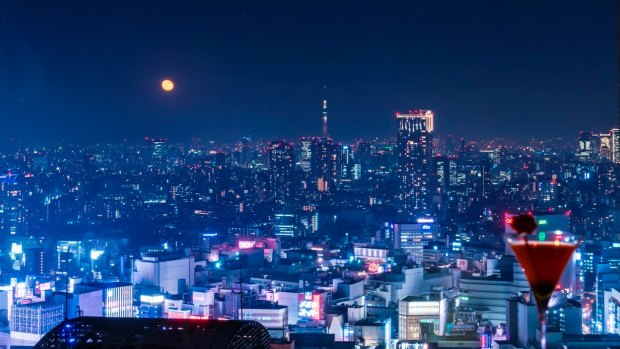
The view from the Aurora Sky lounge at Keio Plaza Hotel.
It's not easy getting an authentic kaiseki meal (the Japanese equivalent of French haute cuisine), even in Tokyo. But tonight we're being served a seven-course seasonal banquet by kimono-clad waitresses in an exquisite bamboo dining room.
Each dish is delivered in impeccable antique ceramics or lacquerware. The only nod to Western sensibilities – thank goodness – is that we don't need to sit, cross-legged, on tatami mats because the authentically low table has a sunken floor space beneath it.
My hamstrings are just beginning to recover from the rigours of the tea ceremony this morning.
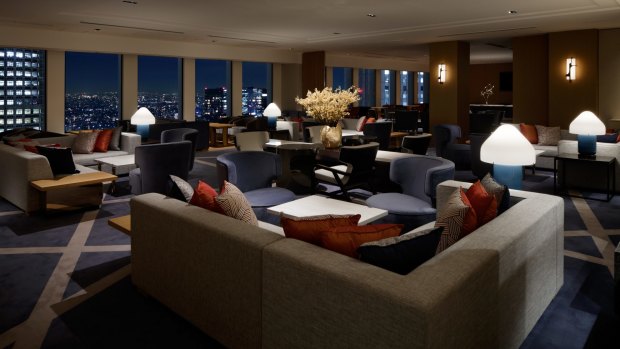
The club lounge at Keio Plaza Hotel.
Waiting in excruciating agony in the correct pose – while Sento Yano, our beautifully costumed female "tea master" prepared a cup of green tea painstakingly slowly – should have been worth a black belt in self-restraint.
Today has been a crammed lesson in authentic Japanese culture, beginning at Kagari with a Japanese breakfast: grilled mackerel, miso soup, rice, quail egg, tofu and so many pickled vegetables it had been hard to focus on the chopsticks.
Then we'd been taken to the kind of rooms usually associated with ryokans (traditional Japanese inns). These had the usual bamboo screens, tatami mats and shikibuton bed rolls (but, fortunately, came with a modern ensuite).
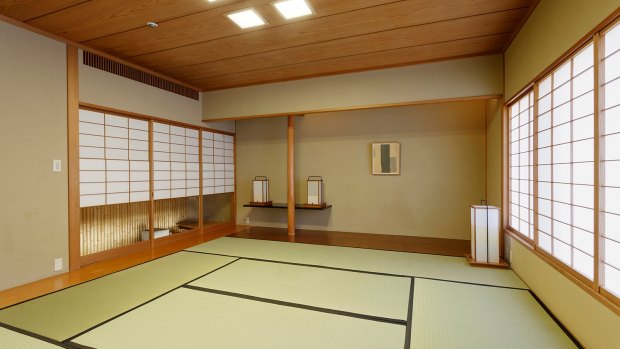
Tatami room, Keio Plaza Hotel.
We'd then been whisked to "bizarre Tokyo".
Hello Kitty, a cartoon figure invented in 1974 and now the centre of a $US5 billion a year merchandising industry, is one of Japan's most enduring kawaii ("cute or adorable" characters).
It's hard to describe how kitsch these pink rooms are, with Hello Kitty dolls, Hello Kitty hairdryers, Hello Kitty wallpaper and Hello Kitty bathrobes.
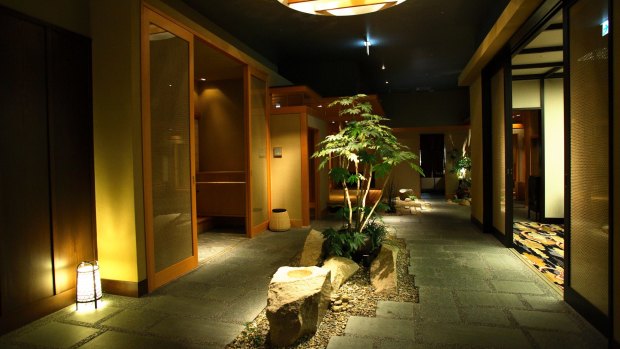
Soujuan restaurant.
But it's even harder to imagine why these excruciatingly crass rooms – there's a choice of Princess Kitty or Kitty Town – are so popular, regularly booked by young men seeking to seduce their equally young girlfriends or wives by treating them like a real-life Princess Kitty.
Thankfully, the next stop had been a sake bar. How many sakes can we choose from? Only 40, says the barman at Amanogawa. (Not enough to recover from Hello Kitty.)
Our afternoon had been spent visiting a Japanese wedding chapel and admiring the contemporary Japanese paintings and ceramics in a local art gallery before being escorted to perhaps Tokyo's most expensive one-bedroom suite. The late, great Muhammad Ali stayed in the Imperial Suite in 1976 when he "fought" Japanese wrestling champion Antonio Inoki in the world's first mixed martial arts contest.
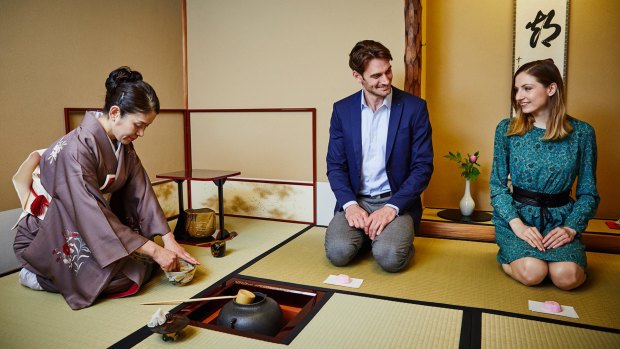
Tea Ceremony, Keio Plaza Hotel.
If the Imperial Suite looks fabulously retro, that's because it has hardly changed in 40 years (and imagine sleeping in the same bed as "The Greatest").
After a short break our party had dashed for pre-dinner Japanese-invented cocktails at Aurora Sky Lounge, on the 45th floor of one of Tokyo's earliest skyscrapers, with an incredible view of the city's LED-lit skyline.
So it was only when I was tucking into the opening "small dish" of our kaiseki meal ("homemade black sesame tofu with angler fish with its liver") that it dawned on me.
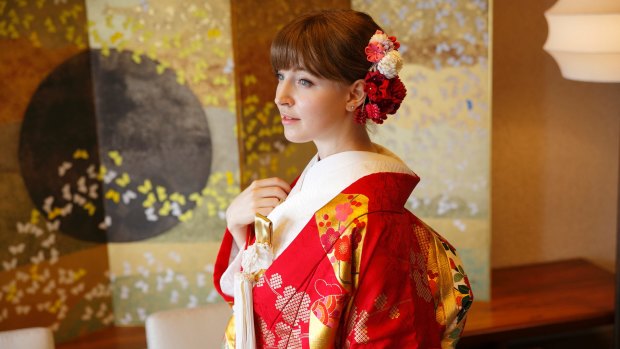
Wedding kimono experience.
In a single day, I had experienced some of the highlights of Japanese culture (though, to be fair I did skip the hotel karaoke bar and resisted the opportunity to sign up for yukata – a "casual kimono experience"). Yet I hadn't even stepped outside the hotel.
Tokyo's Keio Plaza Hotel – unlike most of its four-star rivals in the capital that tend to be part of international hotel chains – is unashamedly Japanese.
Opened in 1971, it was the first skyscraper hotel in Tokyo. It also remains one of the largest hotels in Japan, with 1438 guest rooms and 22 restaurants and bars, with seven restaurants devoted to a particular Japanese cuisine: kaiseki, sushi, teppanyaki, tempura, soba noodles etc.
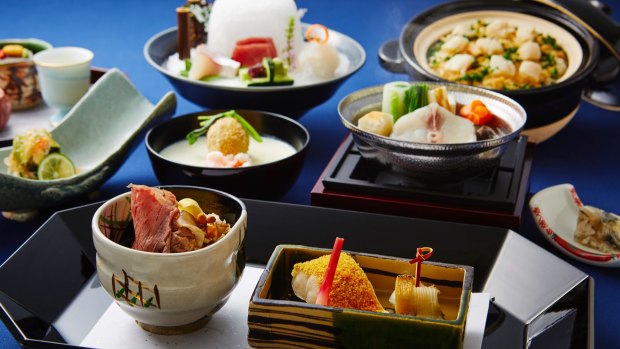
Dishes served at the Soujuan restaurant.
So, why are we here, almost 50 years since the Keio Plaza opened? Because it has recently undergone a multimillion-dollar renovation in preparation for the 2020 Tokyo Olympics.
That has involved the creation of scores of club rooms and club suites, serviced by a top-storey club lounge – where complimentary breakfast, afternoon tea and happy-hour drinks are served, along with office quality Wi-Fi, meeting rooms and chill space.
The view of Tokyo from the 45th-level club lounge and its neighbouring Aurora Sky lounge is spectacular.
Looking west (if the weather is good), there's a glimpse of Mount Fuji, largely obscured by "the Tower of Tax" (otherwise known as Tange Kenzo's twin-towered Tokyo metropolitan government offices). Looking east, you can see as far as Yokohama on a clear day. Gaze below at sunset and you'll spot the seedy side of Shinjuku coming alive.
Shinjuku, once regarded as one of Tokyo's "western suburbs", is firmly established as the city's administrative, commercial and entertainment heartland. Less hip than its neighbour Shibuya, Shinjuku is a Jekyll and Hyde destination.
By day, Dr Jekyll's personality is to the fore. Go for an early morning jog and you'll witness thousands of commuters streaming from Shinjuku station – the busiest in Japan – to their jobs in in western Shinjuku.
By night, Mr Hyde takes over. Eastern Shinjuku – divided from its namesake by the railway line – only really comes alive (unless you're a shopper!) after office work is done for the day.
Then "salary men" (and salary women) flock to Eastern Shinjuku, a safe 10-minute walk from the Keio Plaza. Here you'll find all kinds of Japanese nightlife: karaoke, pachinko, nightclubs, sex shops, dance halls and fantastic street restaurants.
Save a night for "Yakitori Alley" – real name, Omnide Yokocho, tucked away in a rabbit warren of narrow passageways east of the railway line, and serving the most delicious street food in Tokyo. Then there's the "Golden Gai" – Tokyo's version of what Sydney's Kings Cross used to be – transforming, at sunset, into a nocturnal meeting place of exquisitely tiny bars and disreputable clubs.
Was Shinjuku always like this?
No. We're shown a photograph of the Keio Plaza when it opened in 1971. The rest of Shinjuku was then a wasteland. The 45 floors of Keio Plaza seem like a prop in a Godzilla movie after "the King of the Monsters" has destroyed the surrounding landscape.
But back to our traditional kaiseki meal.
The soup is made of "milt, served with a taro ball and shrimp covered with kudzu starch".
I'd thought "milt" was a typo for milk until I looked it up. It's the semen of fish or molluscs.
The nabe course (hotpot) had seemed innocuous enough until the lovely kimono-clad waitress pointed out the main ingredient – fugu – is that deadly poisonous pufferfish that only chefs who have undergone three years of training are allowed to serve by Japanese law.
Glad to survive, I engaged in a little small talk with my waitress as she served the penultimate vinegar dish (hairy crab meat, seaweed, cucumber and ginger jelly).
"How do you rise and fall so gracefully, serving food?" I asked. "I tried it earlier today during the tea ceremony and failed miserably …"
She smiled enigmatically before replying in perfect English. "Knee braces and ankle supports. You'd be surprised what we wear under our kimonos."
TRIP NOTES
MORE
STAY
Keio Plaza Hotel Tokyo, 2-2-1 Nishi-Shinjukyu, Shinjuku-Ku, Tokyo. See keioplaza.com
FLY
Qantas and JAL have direct flights to Tokyo from Sydney and Melbourne (ANA also has direct flights from Sydney). Other airlines, including Jetstar, Virgin Australia and China Airlines, offer connecting flights.
Steve Meacham was a guest of Keio Plaza Hotel Tokyo.
Sign up for the Traveller Deals newsletter
Get exclusive travel deals delivered straight to your inbox. Sign up now.